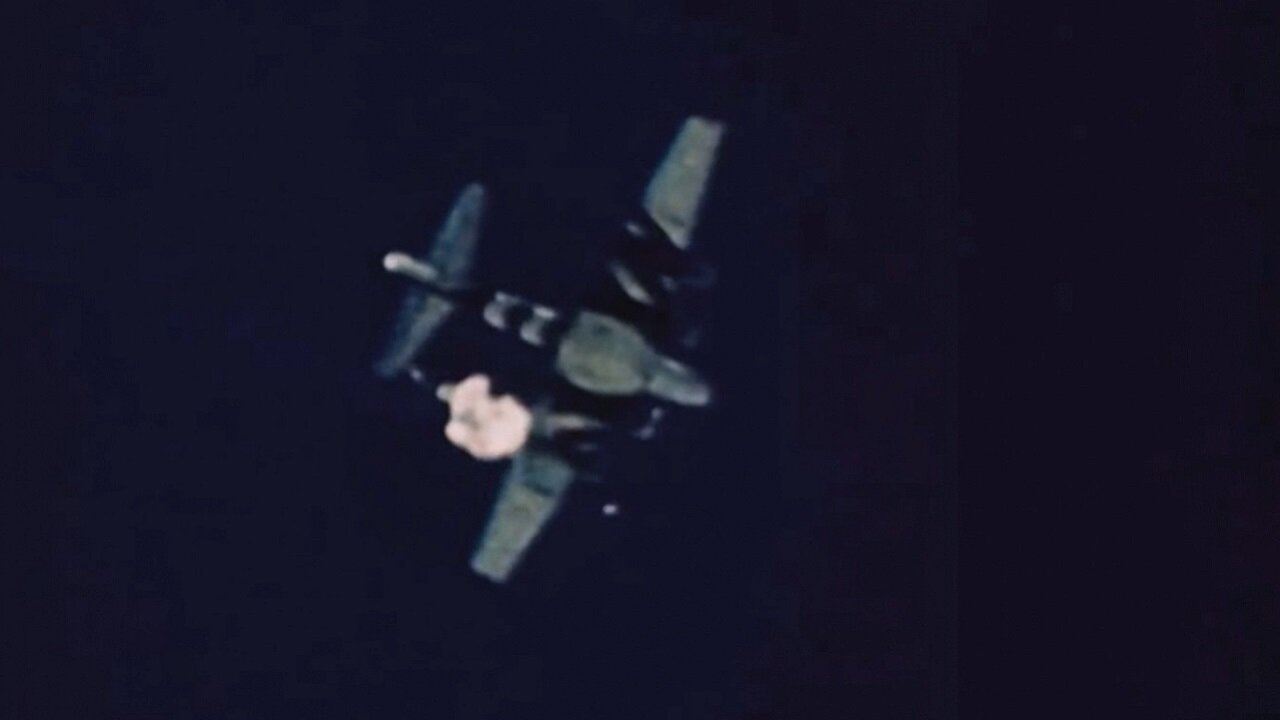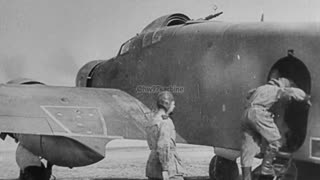Premium Only Content

Early AIM-9 Sidewinder inert missile tests targeting QB-17 drones in 1954
After the end of World War II, a large number of B-17G Flying Fortress bombers became surplus to USAAF (and later USAF) requirements. Some of these were converted to unmanned QB-17 configuration, mostly for use as aerial targets. During the same conflict the B-17 helped to win, various researchers in Germany were working infrared guidance systems of various complexity. The most mature development of these, codenamed Hamburg, was intended for use by the Blohm & Voss BV 143 glide bomb in the anti-shipping role. Hamburg used a single IR photocell as its detector along with a spinning disk with lines painted on it, alternately known as a "reticle" or "chopper". The reticle spun at a fixed speed, causing the output of the photocell to be interrupted in a pattern, and the precise timing of the resulting signal indicated the bearing of the target. Although Hamburg and similar devices like Madrid were essentially complete, the work of mating them to a missile had not been carried out by the time the war ended.
In the immediate post-war era, Allied military intelligence teams collected this information, along with many of the engineers working on these projects. Several lengthy reports on the various systems were produced and disseminated among the western aircraft firms, while a number of the engineers joined these companies to work on various missile projects. By the early 1950s, both the US Air Force and Royal Air Force had started major IR seeker missile projects.
The development of the Sidewinder missile began in 1946 at the Naval Ordnance Test Station (NOTS), Inyokern, California, now the Naval Air Weapons Station China Lake, as an in-house research project conceived by William B. McLean. McLean initially called his effort "Local Fuze Project 602" using laboratory funding, volunteer help and fuze funding to develop what they called a heat-homing rocket.
Sidewinder did not receive official funding until 1951 when the effort was mature enough to show to Admiral William "Deak" Parsons, the Deputy Chief of the Bureau of Ordnance (BuOrd). It subsequently received designation as a program in 1952. Originally called the Sidewinder 1, the first live firing was on 3 September 1952. The missile intercepted a drone for the first time on the 11 September 1953. The missile carried out 51 guided flights in 1954, and in 1955 production was authorized.
-
 1:00
1:00
hw97karbine
17 days agoItalian Savoia Marchetti SM.79 bombers attack British shipping in the Mediterranean in 1940
48 -
 32:53
32:53
SouthernbelleReacts
3 days ago $0.03 earnedNO WAY THEY SHOWED THAT! 😳 | Welcome to Derry S1E2 Reaction
8523 -
 LIVE
LIVE
Reolock
2 hours agoWoW Classic Hardcore | Ultra Blackfathom into Shadowfang?
27 watching -
![[LIVE] POST-SHOW: Halo Infinite | Sgt. Wilky's WARZONEPALOOZA II | Team: Helljumpers | #RumbleGaming #RumbleTakeover](https://1a-1791.com/video/fww1/75/s8/1/8/r/W/x/8rWxz.0kob-small-LIVE-Sgt.-Wilkys-WARZONEPAL.jpg) LIVE
LIVE
Joke65
4 hours ago[LIVE] POST-SHOW: Halo Infinite | Sgt. Wilky's WARZONEPALOOZA II | Team: Helljumpers | #RumbleGaming #RumbleTakeover
187 watching -
 25:00
25:00
marcushouse
13 hours ago $2.86 earnedNext Starship Flight – Sooner Than You Think! 🚀
1.8K5 -
 LIVE
LIVE
SavageJayGatsby
22 hours ago🔥🥃 Spicy Saturday – 🥃🔥
80 watching -
 LIVE
LIVE
FusedAegisTV
10 hours agoFUSEDAEGIS | Generational Video Game?? | Expedition 33 PART I
1,991 watching -
 1:03:09
1:03:09
A Cigar Hustlers Podcast Every Day
2 days agoEpisode 1 Its Starts With One
728 -
 38:52
38:52
Brad Owen Poker
10 hours ago $0.16 earnedI Play $40,000 ALL IN Pots!!! The BIGGEST Game In Las Vegas! Back-To-Back Sets! Poker Vlog Ep 329
1.49K -
 1:26:35
1:26:35
The Shannon Joy Show
1 day agoTrump Tells Americans to STUFF IT: "Thanksgiving Cheaper Than Ever" Exclusive w/ Daniel Horowitz
2.94K13